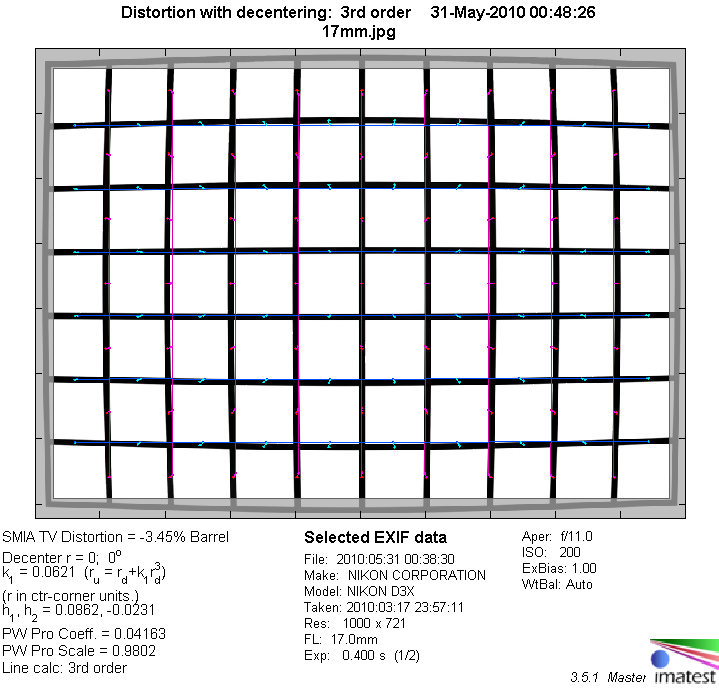|
Tamron AF 17-50mm f/2.8 SP XR Di II LD Aspherical [IF] VC - Review / Test Report - Analysis |
|
Lens Reviews -
Nikon / Nikkor (APS-C)
|
|
Page 2 of 3

Distortion
The AF 17-50mm f/2.8 SP SP XR VC produces a fairly strong degree of barrel distortion at 17mm (3.45%) - in fact this is a bit worse than the non-VC variant of the lens. At 24mm the problem is already very much reduced and no longer annoying. There are no relevant signs of distortion anymore at 35mm and 50mm.
|
Move the mouse cursor over the focal length text marks below to observe the respective distortion
|
| 17mm |
24mm |
35mm |
50mm |
|

|
The chart above has a real-world size of about 120x80cm.
Vignetting
The AF 17-50mm f/2.8 SP XR VC is a dedicated APS-C format lens and these lenses tend to produce comparatively high vignetting figures. The Tamron lens is no exception with an edge darkening of more than one EV (f-stop) at f/2.8 at 17mm and 35mm as well as around 0.8 EV at 24mm and 50mm. Stopping down to f/4 resolves most of the issue although you may still spot a hint of vignetting at 17mm here.

MTF (resolution)
The lens showed a bit of a mixed resolution characteristic in the MTF lab. At 17mm the center performance is great straight from f/2.8 and the borders are also very good. However, the extreme corners are rather unimpressive at f/2.8 but improve significantly at f/4 and beyond. There's a bit of a field curvature problem at this setting. If you require sharp borders/corners you should also avoid f/2.8 at longer focal lengths. However, the center quality remains on a very high level and stopping down improves the performance at f/4.
Please note that the MTF results are not directly comparable across the different systems!
Below is a simplified summary of the formal findings. The chart shows line widths per picture height (LW/PH) which can be taken as a measure for sharpness.
If you want to know more about the MTF50 figures you may check out the corresponding Imatest Explanations
Chromatic Aberrations (CAs)
Lateral Chromatic aberrations (color shadows at harsh contrast transitions) are very well controlled for such a lens. The "worst" figures were measured at 17mm (unsurprisingly) with above 1px at the image borders - this is a very acceptable for a lens in this class. The problem isn't overly field-relevant at longer focal lengths. In addition, CAs can easily be removed in post processing and some of the newer Nikon DSLRs already do this in camera (if you shoot JPG).

Bokeh
We had a brief look at the quality of the bokeh (out-of-focus blur) at 50mm. The blur is generally very smooth both in the fore- and background. Bright out-of-focus highlights can produce an outlining effect at f/2.8 although the effect improves at f/4.
Except some nervousness in front of the focus field (which is not really field-relevant) the Tamron shows very smooth bokeh and a pleasing softness in out of focus areas. Background highlights show a cat's eye shape wide open towards the image borders, but are rendered circular from f/4 onwards.
Please note that these images were taken from the Canon mount review of this lens. However, the quality of the bokeh is a general property of a lens, regardless of the mount, so these images have been reused here.

|